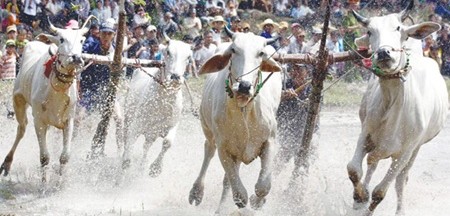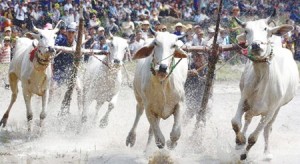Every year at Mekong Delta, Bay Nui (Seven Mountains) Region, An Giang Province, people look forward to the Dolta Festival, an annual celebration made up of colorful costumes, cultural shows, parades, dancing and family dinners. But perhaps most of all, people come in hoardes in anticipation of the popular chariot racing, Vietnam style.
Dolta Festival traces back to the Khmer people who originally practiced the festival as a traditional celebration of their autumn-winter crop planting. Today, the festive affair is greatly attended by not only the ethnic groups in the province, but even outside of and even tourists, both domestic and foreign. In fact, to add more “spirit” to the affair so to speak, some spectators bring and bang pots, pans and other cooking utensils from morning until the afternoon.
This year’s bull race is the 19th celebration since it started during the Khmer times. It will be held at the temple courtyard of Ta Miet in Tri Ton District. It is open to all interested contestants from An Giang and even the nearby provinces. The owners of the bull teams who have come to join this year’s contest come from An Giang Province, from the districts of Tri Ton, Tinh Bien, Chau Thanh, Chau Phu, Thoai Son; Hon Dat and Kien Luong districts from Kien Giang Province; and Takeo Region, Cambodia, expectedly.
Each racing tournament is composed of 38 pairs of bulls which won from the commune level competition. Each animal requires the following qualities in order to be eligible to join the race: big head; straight back; solid bone; long tail; small ear; round neck; and gentle eye.
Each round of the race involves two pairs of bulls which will be yoked to a harrow when the contest starts. The harrow is made of a plank of wood 30 cms. wide and 90 cms. long. The controller then stands on the harrow and waves his whip. But he must do so with a firm stance, as per contest regulations, or lose in the competition. The whip or round stick is made of rattan and called xa lu. At the signal of the referee to begin the race, the controller shoves this xa lu into the bull’s buttock to startle the animal and make it run fast.
The race consists of two rounds: Hu and Tha. Hu is the selection round. Here, each pair of bull has to go around the race ground two times for both warm up and performance. If even one of the pair of bulls steps on the harrow of their competitors, it is a signal for defeat. Tha is the contest proper. In this round, each bull must showcase its strength. At the same time, the animal’s controller must display his skill in order to win the race. The start and finish points are marked with two green and red poles which are 5 meters apart from each other. The bulls in the green lane must reach the finish line of the same color. But while in Hu, stepping on the competitor’s harrow means losing, it is the exact opposite in the 120-meter long Tha round.
Aside from its traditional cause, village men also see bull racing as a chance to show off their “manliness” by displaying their bravery and skills to the public. All in all, the Dolta Festival and chariot competition is a wonderful opportunity for all people from all walks of life to converge in a single place and event to celebrate history and culture and simple have a good, fun time.

